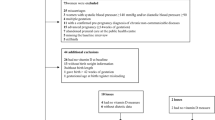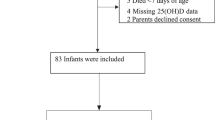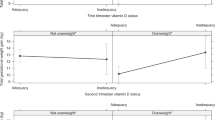Abstract
Objective
To evaluate vitamin D inadequacy among extremely low-birth-weight (ELBW, <1000 g) infants and the association between circulating vitamin D concentrations and perinatal–neonatal outcomes.
Study design
Prospective cohort study of ELBW infants in the neonatal ICU. Blood was collected within the first 3 days after birth after obtaining informed consent. Circulating 25-hydroxyvitamin D concentrations (25(OH)D) were quantified using liquid chromatography–tandem mass spectroscopy and classified as vitamin D deficient, insufficient, or adequate ( < 20, 20–30, or > 30 ng/mL, respectively). Associations between 25(OH)D and perinatal–neonatal outcomes were determined by multivariable regression, adjusted for covariates that differ in the bivariate analysis.
Results
Of the 60 ELBW infants enrolled, 13 (22%) were vitamin D deficient, 15 (25%) were insufficient, and 32 (53%) were adequate. 25(OH)D levels were positively associated with fetal growth restriction and prolonged rupture of the membranes.
Conclusions
Vitamin D inadequacy was frequent among ELBW infants. Circulating vitamin D concentrations were significantly associated with perinatal outcomes in this contemporary cohort.
This is a preview of subscription content, access via your institution
Access options
Subscribe to this journal
Receive 12 print issues and online access
$259.00 per year
only $21.58 per issue
Buy this article
- Purchase on Springer Link
- Instant access to full article PDF
Prices may be subject to local taxes which are calculated during checkout
Similar content being viewed by others
References
Stoll BJ, Hansen NI, Bell EF, Walsh MC, Carlo WA, Shankaran S, et al. Trends in care practices, morbidity, and mortality of extremely preterm neonates, 1993-2012. JAMA. 2015;314:1039–51.
Underwood MA. Human milk for the premature infant. Pediatr Clin North Am. 2013;60:189–207.
Dror DK, Allen LH. Vitamin D inadequacy in pregnancy: biology, outcomes, and interventions. Nutr Rev. 2010;68:465–77.
Lange NE, Litonjua A, Hawrylowicz CM, Weiss S. Vitamin D, the immune system and asthma. Expert Rev Clin Immunol. 2009;5:693–702.
Barker DJ, Osmond C. Infant mortality, childhood nutrition, and ischaemic heart disease in England and Wales. Lancet. 1986;1:1077–81.
Hart PH, Lucas RM, Walsh JP, Zosky GR, Whitehouse AJ, Zhu K, et al. Vitamin D in fetal development: findings from a birth cohort study. Pediatrics. 2015;135:e167–73.
Hollis BW, Wagner CL. New insights into the vitamin D requirements during pregnancy. Bone Res. 2017;5:17030.
De-Regil LM, Palacios C, Lombardo LK, Pena-Rosas JP Vitamin D supplementation for women during pregnancy. Cochrane Database Syst Rev. 2016;CD008873.
Holick MF, Siris ES, Binkley N, Beard MK, Khan A, Katzer JT, et al. Prevalence of Vitamin D inadequacy among postmenopausal North American women receiving osteoporosis therapy. J Clin Endocrinol Metab. 2005;90:3215–24.
Holick MF, Binkley NC, Bischoff-Ferrari HA, Gordon CM, Hanley DA, Heaney RP, et al. Evaluation, treatment, and prevention of vitamin D deficiency: an endocrine society clinical practice guideline. J Clin Endocrinol Metab. 2011;96:1911–30.
Fenton TR, Kim JH. A systematic review and meta-analysis to revise the Fenton growth chart for preterm infants. BMC Pediatr. 2013;13:59.
Higgins RD, Saade G, Polin RA, Grobman WA, Buhimschi IA, Watterberg K, et al. Evaluation and management of women and newborns with a maternal diagnosis of chorioamnionitis: summary of a workshop. Obstet Gynecol. 2016;127:426–36.
Walsh MC, Kliegman RM. Necrotizing enterocolitis: treatment based on staging criteria. Pediatr Clin North Am. 1986;33:179–201.
International Committee for the Classification of Retinopathy of P. The international classification of retinopathy of prematurity revisited. Arch Ophthalmol. 2005;123:991–9.
Kovacs CS. Vitamin D in pregnancy and lactation: maternal, fetal, and neonatal outcomes from human and animal studies. Am J Clin Nutr. 2008;88:520S–8S.
Wierzejska R, Jarosz M, Sawicki W, Bachanek M, Siuba-Strzelinska M Vitamin D concentration in maternal and umbilical cord blood by season. Int J Environ Res Public Health. 2017;14(10):1121–30.
Fort P, Salas AA, Nicola T, Craig CM, Carlo WA, Ambalavanan N. A comparison of 3 vitamin D dosing regimens in extremely preterm infants: a randomized controlled trial. J Pediatr. 2016;174:132–8 e1.
Tergestina M, Rebekah G, Job V, Simon A, Thomas N. A randomized double-blind controlled trial comparing two regimens of vitamin D supplementation in preterm neonates. J Perinatol. 2016;36:763–7.
Yu RQ, Zhao X, Chen DZ, Liao XP, Zhou Q. [Vitamin D level at birth and influencing factors in preterm infants]. Zhongguo Dang Dai Er Ke Za Zhi. 2017;19:800–5.
Yazdanpanah M, Bailey D, Walsh W, Wan B, Adeli K. Analytical measurement of serum 25-OH-vitamin D(3), 25-OH-vitamin D(2) and their C3-epimers by LC-MS/MS in infant and pediatric specimens. Clin Biochem. 2013;46:1264–71.
Bailey D, Perumal N, Yazdanpanah M, Al Mahmud A, Baqui AH, Adeli K, et al. Maternal-fetal-infant dynamics of the C3-epimer of 25-hydroxyvitamin D. Clin Biochem. 2014;47:816–22.
Wortsman J, Matsuoka LY, Chen TC, Lu Z, Holick MF. Decreased bioavailability of vitamin D in obesity. Am J Clin Nutr. 2000;72:690–3.
Haagensen AL, Feldman HA, Ringelheim J, Gordon CM. Low prevalence of vitamin D deficiency among adolescents with anorexia nervosa. Osteoporos Int. 2008;19:289–94.
Cooper NA, Moores R. East London Preterm Prevention C. A review of the literature regarding nutritional supplements and their effect on vaginal flora and preterm birth. Curr Opin Obstet Gynecol. 2014;26:487–92.
Calton EK, Keane KN, Newsholme P, Soares MJ. The impact of vitamin D levels on inflammatory status: a systematic review of immune cell studies. PLoS ONE. 2015;10:e0141770.
Gibson CC, Davis CT, Zhu W, Bowman-Kirigin JA, Walker AE, Tai Z, et al. Dietary vitamin D and its metabolites non-genomically stabilize the endothelium. PLoS ONE. 2015;10:e0140370.
Al-Garawi A, Carey VJ, Chhabra D, Mirzakhani H, Morrow J, Lasky-Su J, et al. The role of vitamin D in the transcriptional program of human pregnancy. PLoS ONE. 2016;11:e0163832.
Javorski N, Lima CAD, Silva LVC, Crovella S, de Azevedo Silva J. Vitamin D receptor (VDR) polymorphisms are associated to spontaneous preterm birth and maternal aspects. Gene. 2018;642:58–63.
Say B, Uras N, Sahin S, Degirmencioglu H, Oguz SS, Canpolat FE. Effects of cord blood vitamin D levels on the risk of neonatal sepsis in premature infants. Korean J Pediatr. 2017;60:248–53.
Joung KE, Burris HH, Van Marter LJ, McElrath TF, Michael Z, Tabatabai P, et al. Vitamin D and bronchopulmonary dysplasia in preterm infants. J Perinatol. 2016;36:878–82.
Onwuneme C, Martin F, McCarthy R, Carroll A, Segurado R, Murphy J, et al. The association of vitamin D status with acute respiratory morbidity in preterm infants. J Pediatr. 2015;166:1175–80 e1.
Koroglu OA, Onay H, Cakmak B, Bilgin B, Yalaz M, Tunc S, et al. Association of vitamin D receptor gene polymorphisms and bronchopulmonary dysplasia. Pediatr Res. 2014;76:171–6.
Shah BA, Padbury JF. Neonatal sepsis: an old problem with new insights. Virulence. 2014;5:170–8.
Shah BA, Migliori A, Kurihara I, Sharma S, Lim YP, Padbury J. Blood level of inter-alpha inhibitor proteins distinguishes necrotizing enterocolitis from spontaneous intestinal perforation. J Pediatr. 2017;180:135–40 e1.
Vo P, Bair-Merritt M, Camargo CA. The potential role of vitamin D in the link between obesity and asthma severity/control in children. Expert Rev Respir Med. 2015;9:309–25.
Couchman L, Moniz CF. Analytical considerations for the biochemical assessment of vitamin D status. Ther Adv Musculoskelet Dis. 2017;9:97–104.
Acknowledgements
We acknowledge Itsuka Kurihara and Alison Migliori at the Women and Infants Hospital of Rhode Island for assistance in data collection, and Drs. Marilyn Escobedo and Rita Raman at the University of Oklahoma for their assistance.
Author information
Authors and Affiliations
Corresponding author
Ethics declarations
Conflict of interest
The authors declare that they have no conflict of interest.
Additional information
Portions of the study were presented at the annual meeting of the Pediatric Academic Societies, San Francisco, CA, May 6–9 2017.
Rights and permissions
About this article
Cite this article
Shah, B.A., Padbury, J.F., Anderson, M.P. et al. Vitamin D and associated perinatal–neonatal outcomes among extremely low-birth-weight infants. J Perinatol 38, 1318–1323 (2018). https://doi.org/10.1038/s41372-018-0203-y
Received:
Revised:
Accepted:
Published:
Issue Date:
DOI: https://doi.org/10.1038/s41372-018-0203-y



